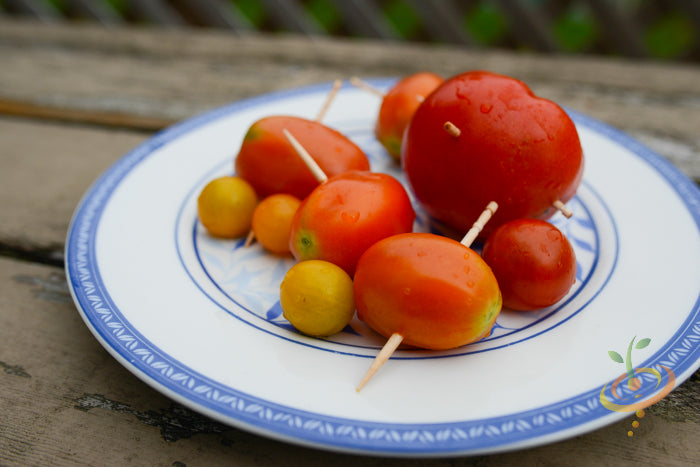
Summertime means an abundance of tomatoes for most home gardeners, and along with that means finding new ways to preserve harvests when there's too much to eat fresh.

An easy and delicious way to preserve some of your homegrown smaller tomatoes, such as the cherry and pear varieties are to pickle them. Don't worry, this is a recipe that requires no special equipment such as waterbath canners, or canning tools at all, really.
What you will need:
20-30 small tomatoes (cherry and pear varieties work great)
-you can also use small romas-
1 pint container, such as mason jar, or anything with a lid.
1/2 cup vinegar
1/2 cup water
1/2 Tbsp. pickling spice
1 Tbsp. sugar

Pick 20-30 small tomatoes. We recommend Tiny Tim, Yellow Pear, Red Pear, White Cherry, Red Cherry, Chocolate Cherry & Black Cherry tomatoes for a recipe like this, but really, any small tomato will work.


Wash all of your tomatoes and remove stems.

If you're using a few tomatoes that are larger than the cherry varieties, run a toothpick through them. This will help the brine to enter the center of the tomato. You don't need to do this with any of the cherry varieties. They are small enough. Remove toothpicks and put all of the tomatoes into a 1 pint container.

With 20-30 tomatoes, you should be able to fill a 1 pint container nicely.


Add 1/2 Tbsp. of your favorite pickling spice to the container.


Go ahead and in a small saucepan heat together 1/2 cup vinegar, 1/2 cup water & 1 Tbsp of sugar until the sugar is dissolved.

Pour hot brine over your tomatoes into your container.

Seal container with a clean lid and let cool slightly before moving it into the refrigerator.
As you can see, the smaller tomatoes skin will split slightly, allowing the brine to enter the center of the tomato, and the holes you poked in any larger tomatoes will help do the same.
Let tomatoes marinate for a week, and then open to enjoy. Add them to sandwiches or salads. Pair them with a cheese plate or eat them right out of the jar.












1 comment
Renée
Such a wonderfully informative article!
Thank you.